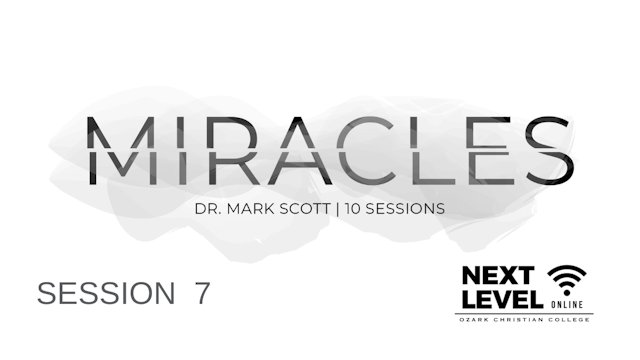Numbers, Categories, and Elements of the Miracles of Jesus


The vision of Ozark Christian College is to glorify God by evangelizing the lost and edifying Christians worldwide. The mission of Ozark Christian College is to train men and women for Christian service as a degree-granting institution of biblical higher education.
In this lesson we want to group three different concerns that relate to the miracles of Jesus. They are: discerning the numbers of miracles (how many are there?), the categories of those miracles (which might be a Western construct anyway), and the elements of the miracles (how do they come to us?).
The Numbers of Miracles:
Don’t want to make this harder than it is. But it can be a bit tricky. For instance:
Similar to parables there seems to be about 40-50 or so. Here is my own breakdown. I might say if you look at Blackburn’s article in The Dictionary of Jesus and the Gospels, 551, you will see some other numbers. These are the result of my own inductive study:
As stated earlier some suggest that Mark’s Gospel is about 31% miracles. I think you can see that miracles occupied a large portion of Jesus’ ministry.
The Categories of Miracles:
Again the very desire to categorize them may be a Western construct. But for pedagogical purposes there may still be cause to think about them this way
Here are some categories:
special.
- **Power Over the Spirit World:**
- Exorcisms—most famous would be Mk. 5:1-20 and Mk. 9:14-29.
- Jesus talked to demons, granted their requests, and hushed them.
- They most often spoke of his identity.
- One thing that Jesus’ exorcisms prove is that he believed that the spirit world was real.
- **Power Over Illness:**
- Leprosy.
- Paralyzed.
- Withered hands.
- Blind eyes.
- Lame feet.
- Deaf ears.
- Dumb tongues.
- Flow of blood.
- Fever.
- **Power Over Death:**
- Widow’s boy at Nain (Lk. 7).
- Jairus’ daughter (Mk. 5).
- Lazarus (Jn. 11).
Michael Graves (Sermon as Symphony) has different categories:
The Elements of the Miracles:
One caution might be not to let the form override the content—Craddock with Jn. 9.
Next we want to turn to watching for intensifications and distinctives in miracle stories.
In this lesson we want to group three different concerns that relate to the miracles of Jesus. They are: discerning the numbers of miracles (how many are there?), the categories of those miracles (which might be a Western construct anyway), and the elements of the miracles (how do they come to us?).
The Numbers of Miracles:
Don’t want to make this harder than it is. But it can be a bit tricky. For instance:
Similar to parables there seems to be about 40-50 or so. Here is my own breakdown. I might say if you look at Blackburn’s article in The Dictionary of Jesus and the Gospels, 551, you will see some other numbers. These are the result of my own inductive study:
As stated earlier some suggest that Mark’s Gospel is about 31% miracles. I think you can see that miracles occupied a large portion of Jesus’ ministry.
The Categories of Miracles:
Again the very desire to categorize them may be a Western construct. But for pedagogical purposes there may still be cause to think about them this way
Here are some categories:
special.
- **Power Over the Spirit World:**
- Exorcisms—most famous would be Mk. 5:1-20 and Mk. 9:14-29.
- Jesus talked to demons, granted their requests, and hushed them.
- They most often spoke of his identity.
- One thing that Jesus’ exorcisms prove is that he believed that the spirit world was real.
- **Power Over Illness:**
- Leprosy.
- Paralyzed.
- Withered hands.
- Blind eyes.
- Lame feet.
- Deaf ears.
- Dumb tongues.
- Flow of blood.
- Fever.
- **Power Over Death:**
- Widow’s boy at Nain (Lk. 7).
- Jairus’ daughter (Mk. 5).
- Lazarus (Jn. 11).
Michael Graves (Sermon as Symphony) has different categories:
The Elements of the Miracles:
One caution might be not to let the form override the content—Craddock with Jn. 9.
Next we want to turn to watching for intensifications and distinctives in miracle stories.
© Live Church Solutions. All rights reserved.
